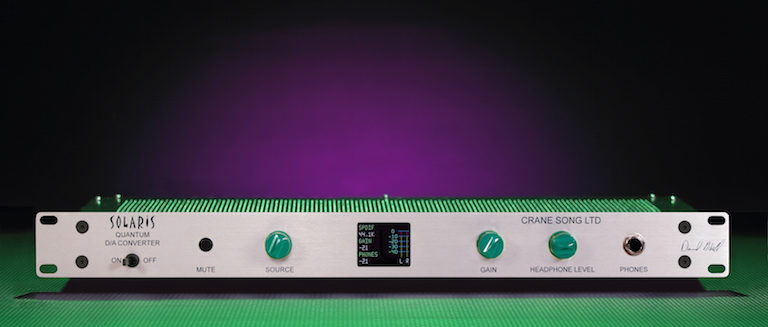Previously, I had been doing all my final monitoring using the outputs built into my Universal Audio Apollo. The headphone output on the Apollo itself had become crackly and sounded pretty grainy and bloated to me, so I upgraded to a Little Labs “Monotor” for critical headphone amplification duties in 2015 or so. However, over time I started having some issues with the gain-staging between Apollo and the Monotor. An upgrade was in order and it had to be something any mastering studio would be proud of. I really wanted something that offered the absolute best in D/A conversion, clocking and headphone amplification. After some exhaustive research and quite a few conversations with peers (thanks Warren!), I decided i was going to buy a Crane Song Solaris Quantum D/A Converter ($1,899, from Lunchbox Audio).
Unpacking and installing the new unit was very simple and the box itself looked, felt and even smelled like a million bucks. I already knew how I was going to hook it into my mastering console, so all it needed was to make few quick connections and I was off and running.
Using my trusted Oppo PM-3 headphones and Focal Solo loudspeakers, I started listening to most of my reference tracks and was quite shocked by what I was hearing! After a few songs, I felt let down by what sounded like a lack of musicality and sheen. In fact, some of my favorite reference tracks sounded like they were pixelated and/or rubbery in a digital sort of way. I remember thinking- “Wow, I thought this thing would sound….better”! As I listened to more tracks of varying styles and quality, it slowly became apparent that I was hearing much more honesty and details than I was used to. Very dynamic, unprocessed mixes sounded full of energy, depth and the stereo field was beyond belief- not just wide, but also full of dimension and height. Recordings made with poor quality converters, mixes with sloppy engineering and compressed masters sounded exceedingly harsh, flat and sometimes even “phase-y”, in ways I had never heard before. After this first listening session I was actually re-thinking how I felt about some of these references that I thought I knew so well.

In order to make sure my ears weren’t lying to me, I A/B tested the Solaris against my previous setup. That is when it became extremely apparent that the older chain was coloring everything I heard with a certain smudgy and yet sparkly characteristic. On some tracks, this made the music sound better and usually a little “hyped”, but that’s definitely not what a mastering engineer wants. The Solaris was allowing me to hear all the details in complete honesty so that I could proceed with any processing with full confidence.
Now that I have used the Solaris almost every single day since, I am very used to it’s clarity and have come to depend on trusting it’s sound 100%. Also, the digitally-stepped output levels for both the headphone amp and main outputs does wonders for a calibrated monitoring system. I think I have found EXACTLY what I have been looking for and don’t see upgrading this unit anytime soon.
© 2024 Fuzzywallz Recordings LLC